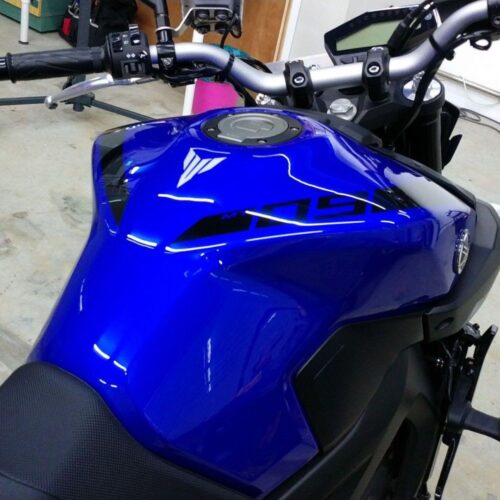Advanced Motorcycle Ceramic Coating: Ingenious Defense for each Cyclist
Advanced Motorcycle Ceramic Coating: Ingenious Defense for each Cyclist
Blog Article
Unleash the Potential of Your Bike With Ceramic Covering: a Comprehensive Step-By-Step Overview

Advantages of Ceramic Finish
Enhancing the resilience and look of your motorbike, ceramic covering gives a safety layer that drives away dust and impurities, making upkeep much easier and prolonging the life expectancy of the vehicle. This innovative coating forms a semi-permanent bond with the surface area of the motorbike, creating a hydrophobic barrier that prevents water places, oxidation, and UV damage. By decreasing the adhesion of dirt and gunk, ceramic covering not just maintains your motorcycle looking excellent yet likewise reduces the need for regular cleans and describing.
Furthermore, the chemical resistance of ceramic covering guards the motorbike's paint from rough chemicals and toxic wastes, such as bird droppings and tree sap, that can cause etching and discoloration. This safety layer likewise provides UV defense, protecting against the paint from fading or discolouring gradually because of sun direct exposure. Ultimately, investing in ceramic coating for your motorbike not only improves its aesthetic charm but additionally simplifies upkeep regimens and preserves its problem for years ahead.
Required Devices and Materials
What essential tools and materials are needed for using ceramic coating to your motorbike? To effectively use ceramic covering to your motorbike, you will need a set of necessary tools and materials.
Other required tools include applicator pads or towels for spreading the ceramic finish, covering up tape to shield delicate locations from accidental application, and handwear covers to maintain your hands clean during the process. It is also advised to have some isopropyl alcohol on hand for cleaning the surface of the motorcycle prior to using the ceramic covering. Lastly, having a well-ventilated workspace or functioning outdoors is crucial to guarantee appropriate ventilation while applying the ceramic layer to your bike.

Preparing Your Bike Surface
Before using ceramic layer to your motorbike, extensive surface area preparation is important to make certain optimal attachment and durability of the coating. Begin by cleaning your motorbike with a pH-neutral shampoo to remove dust, grease, and impurities.
After fixing any type of imperfections, make use of an alcohol-based paint cleaner to further cleanse the surface area and remove any remaining residues. This action is important as it makes certain a clean canvas for the ceramic layer to bond successfully. As soon as the surface is tidy and smooth, use a paint preparation or surface preparation item to eliminate any kind of staying oils or deposits that could hinder the bonding procedure.
Using Ceramic Covering
Having actually try these out carefully prepared the surface area of your motorbike, the next important step is the accurate application of ceramic layer to ensure lasting defense and a shiny surface. Shake the ceramic finishing container well prior to usage to ensure an uniform consistency.
As soon as applied, allow the covering to heal for the advised time according to the manufacturer's instructions. Typically, this varies from 1 to 5 minutes depending on the details product. After the curing duration, carefully buff the surface area with a tidy, dry microfiber cloth to reveal a high-gloss luster. For optimal outcomes, prevent revealing the motorbike to water or other elements for at the very least 24-hour to enable the ceramic covering to fully cure and bond to the surface. This thorough application process will certainly not only enhance the aesthetic appeal of your bike however likewise offer durable security versus environmental impurities.
Maintenance Tips for Longevity

Evaluating your motorcycle routinely for any signs of damage to the ceramic coating, such as chips or scrapes, and resolving them immediately can assist preserve the integrity of the coating. Using a ceramic finish booster or spray sealer every few months can also aid renew the coating and offer added defense against environmental components.
Finally, keeping your motorcycle in a garage or covered location when not in usage can shield it from long term exposure to sunshine, rainfall, and other detrimental variables that can use down the ceramic finishing - motorcycle ceramic coating. By adhering to these maintenance tips, you can make certain that your motorbike's ceramic covering continues to be effective and sturdy for an extensive period
Verdict
In conclusion, ceramic finish can greatly enhance the appearance and security of your motorcycle. Appropriate prep work, application, and upkeep are key to optimizing the advantages of ceramic coating.
It is also suggested to have some isopropyl alcohol on hand for cleaning the surface of the motorbike before applying the ceramic finishing. motorcycle ceramic coating. Having a well-ventilated work space or functioning outdoors is crucial to ensure proper ventilation while using the ceramic coating to your motorcycle
Before applying ceramic coating to your motorcycle, comprehensive surface prep work is vital to ensure optimal bond and longevity of the finishing.Having actually meticulously prepared the surface of your motorcycle, the next critical action is the specific application of ceramic finish to make sure enduring security and a glossy finish. For optimal outcomes, prevent subjecting the motorcycle to water or various other components for official statement at the very least 24 hours to enable the ceramic covering to fully heal and bond to the surface.
Report this page